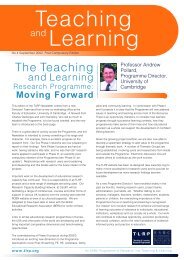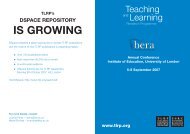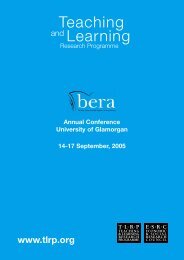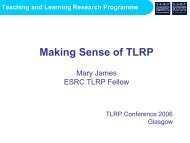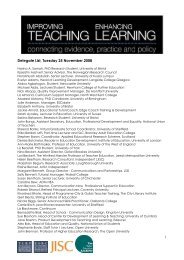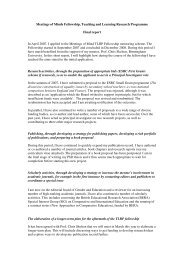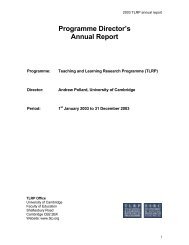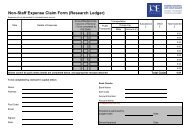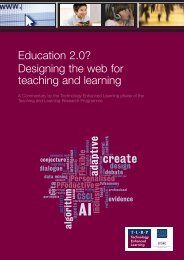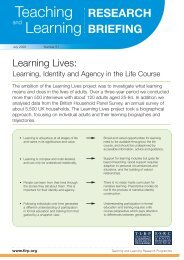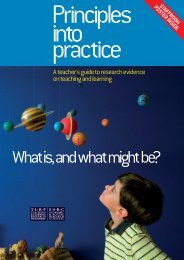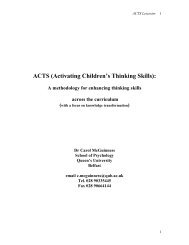Assessment in schools Fit for purpose? - Teaching and Learning ...
Assessment in schools Fit for purpose? - Teaching and Learning ...
Assessment in schools Fit for purpose? - Teaching and Learning ...
You also want an ePaper? Increase the reach of your titles
YUMPU automatically turns print PDFs into web optimized ePapers that Google loves.
Align<strong>in</strong>g assessment with curriculum: the case of school<br />
mathematics <strong>in</strong> Engl<strong>and</strong><br />
What should be taught <strong>and</strong> there<strong>for</strong>e assessed <strong>in</strong> school mathematics cont<strong>in</strong>ues to be controversial.<br />
Groups differ <strong>in</strong> their views of the aims of mathematics education, over the teach<strong>in</strong>g needed to<br />
secure these aims, <strong>and</strong> over the means to assess their achievement. The operational mean<strong>in</strong>g of<br />
their aims is often not clear, <strong>and</strong> the means are often ill thought-out <strong>and</strong> ill <strong>in</strong><strong>for</strong>med. Yet some<br />
consensus about what constitutes “school mathematics” is needed if valid assessments are to be<br />
developed. In other words there is a need to clarify the “construct” be<strong>for</strong>e valid measures can be<br />
developed to assess it.<br />
Current views about what school mathematics should be are often quite different. One view is that<br />
mathematics is the per<strong>for</strong>mance of rout<strong>in</strong>e algorithms; another sees mathematics as a tool to tackle<br />
“everyday” or “real world” problems. The <strong>for</strong>mer leads to assessment of achievement with welldef<strong>in</strong>ed<br />
exercises, which have a s<strong>in</strong>gle right answer, with learners <strong>in</strong>cl<strong>in</strong>ed to th<strong>in</strong>k of achievement<br />
as arriv<strong>in</strong>g at that answer. The latter looks <strong>for</strong> evidence of a capacity to tackle the rather messy<br />
contexts which are characteristic of every-day problems: problems <strong>for</strong> which there is no right<br />
answer, <strong>and</strong> where explanation of the way the problem has been def<strong>in</strong>ed, <strong>and</strong> of the approach<br />
adopted, is as important as the “answer” itself. Such work is much more dem<strong>and</strong><strong>in</strong>g to guide, <strong>and</strong><br />
harder to assess. Yet pupils taught <strong>in</strong> this way achieve as well <strong>in</strong> the GCSE as those taught <strong>in</strong> more<br />
traditional methods. They also take more <strong>in</strong>terest <strong>in</strong> the subject, are better able to see mathematics<br />
as useful <strong>in</strong> everyday life <strong>and</strong> better able to tackle unusual problems.<br />
The test<strong>in</strong>g system is of course of crucial importance here. With time-limited tests to cover a very full<br />
curriculum, any activity that <strong>in</strong>volves much more time than that <strong>in</strong> which a s<strong>in</strong>gle exam<strong>in</strong>ation answer<br />
can be given is not possible. There<strong>for</strong>e realistic problems are ruled out. This results <strong>in</strong> an <strong>in</strong>validity<br />
block, which could <strong>in</strong> pr<strong>in</strong>ciple be cleared by strengthen<strong>in</strong>g the use of teachers’ own assessments <strong>in</strong><br />
national tests <strong>and</strong> public exam<strong>in</strong>ations. The experience of a recent project, which aimed to explore<br />
<strong>and</strong> develop teachers’ summative assessments, was that mathematics teachers can develop their<br />
own summative assessment <strong>in</strong> ways that they f<strong>in</strong>d reward<strong>in</strong>g <strong>and</strong> which can produce dependable<br />
results. But such development is difficult to achieve.<br />
Thus, whilst the National Curriculum can be <strong>in</strong>terpreted as reflect<strong>in</strong>g a valid representation of<br />
mathematics, the test<strong>in</strong>g system does not realise this potential. To repair this mis-alignment requires<br />
changes that dem<strong>and</strong> professional development <strong>for</strong> teachers, <strong>and</strong> a consensus about the aims of<br />
mathematics education, which does not at present exist.<br />
Sources:<br />
Advisory Committee on Mathematics Education (ACME) (2005) <strong>Assessment</strong> 14-19 Mathematics.<br />
London: The Royal Society.<br />
Black, P., Harrison, C., Hodgen, J., Marshall, B. & Serret, N. (under review) Validity <strong>in</strong> teachers’<br />
summative assessments, <strong>Assessment</strong> <strong>in</strong> Education.<br />
Daugherty, .R., Black, P., Ecclestone, K., James, M. & Newton. P. (2010, <strong>in</strong> press)<br />
Chapter 9: <strong>Assessment</strong> of Significant Learn<strong>in</strong>g Outcomes. In R. Berry & R. Adamson (Eds.)<br />
<strong>Assessment</strong> Re<strong>for</strong>m <strong>and</strong> Educational Change, New York: Spr<strong>in</strong>ger.<br />
Ernest, P. (2000) Why teach mathematics? In S. Bramail & J. White (Eds.) Why learn maths?<br />
London: Institute of Education.



